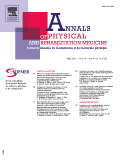
Annals of Physical and Rehabilitation Medicine
Scope & Guideline
Elevating Standards in Physical Medicine Research
Introduction
Aims and Scopes
- Rehabilitation Interventions:
The journal publishes studies on various rehabilitation interventions, including physical therapy, occupational therapy, and innovative treatments like telerehabilitation and robotic assistance, aimed at improving functional outcomes for individuals with disabilities. - Clinical Outcomes and Effectiveness:
A significant focus is on evaluating clinical outcomes and effectiveness of rehabilitation programs, including randomized controlled trials and systematic reviews that assess factors influencing recovery and quality of life. - Neurorehabilitation:
The journal emphasizes neurorehabilitation, featuring research on rehabilitation strategies for neurological conditions, including stroke, traumatic brain injury, and disorders of consciousness, highlighting the integration of cognitive and physical rehabilitation. - Chronic Conditions and Pain Management:
Research addressing chronic diseases, including chronic obstructive pulmonary disease (COPD), musculoskeletal disorders, and pain management strategies, is a core area, exploring both pharmacological and non-pharmacological interventions. - Innovative Methodologies:
The journal supports innovative methodologies, including the use of advanced imaging techniques, virtual reality, and wearable technology to assess and enhance rehabilitation practices. - Patient-Centered Approaches:
A commitment to patient-centered approaches is evident, with studies focusing on patient-reported outcomes, satisfaction, and the impact of social determinants on rehabilitation.
Trending and Emerging
- Telehealth and Remote Rehabilitation:
There is a growing focus on telehealth and remote rehabilitation methods, particularly following the COVID-19 pandemic, which has accelerated the adoption of digital health solutions to provide accessible rehabilitation services. - Neuroplasticity and Recovery Mechanisms:
Research exploring neuroplasticity and the underlying mechanisms of recovery, especially in neurological rehabilitation, is gaining traction, emphasizing the need for innovative approaches to enhance functional outcomes. - Holistic and Multidisciplinary Approaches:
An emerging trend is the emphasis on holistic and multidisciplinary rehabilitation approaches that incorporate physical, cognitive, and psychological strategies to optimize patient outcomes. - Use of Technology in Rehabilitation:
The integration of technology, such as virtual reality, robotics, and wearable devices for assessment and rehabilitation, is becoming increasingly prevalent, indicating a shift towards more interactive and engaging rehabilitation methods. - Focus on Chronic Conditions and Aging Population:
The journal is increasingly addressing issues related to chronic conditions and the aging population, emphasizing the need for tailored rehabilitation strategies to improve quality of life for older adults and individuals with chronic illnesses.
Declining or Waning
- Traditional Physical Therapy Techniques:
There appears to be a decline in studies focused solely on traditional physical therapy techniques, as more research shifts towards integrated, multimodal approaches that combine various therapeutic modalities. - Long-term Rehabilitation Studies:
Longitudinal studies investigating long-term rehabilitation outcomes seem less frequent, potentially due to a shift in focus towards immediate and short-term effectiveness of interventions. - Pharmacological Interventions:
Research on purely pharmacological interventions for rehabilitation-related conditions is less prominent, indicating a broader interest in holistic and non-pharmacological approaches. - General Population Studies:
There has been a decrease in studies focusing on general population rehabilitation outcomes, with more emphasis on specific patient populations or conditions, such as those with chronic illnesses or neurological impairments. - In-person Rehabilitation Models:
The traditional in-person rehabilitation models are seeing less emphasis, as the field increasingly embraces telehealth and remote rehabilitation strategies.
Similar Journals

Annals of Rehabilitation Medicine-ARM
Pioneering Discoveries in the Field of RehabilitationAnnals of Rehabilitation Medicine (ARM), published by the Korean Academy of Rehabilitation Medicine, is a distinguished open-access journal dedicated to advancing the field of rehabilitation medicine since its inception in 1977. With its E-ISSN 2234-0653, ARM aims to disseminate high-quality, peer-reviewed research that reflects both the breadth and depth of rehabilitation practices. As of 2023, the journal ranks in the Q2 quartile within the Rehabilitation category, placing it among the top half of journals in this domain, and it holds a respectable position in the Scopus rankings, being 70th out of 161 in the discipline. This journal emphasizes the importance of innovative research and clinical practices that improve patient outcomes in rehabilitation settings. Researchers, clinicians, and students alike will find valuable insights and the latest developments in rehabilitation science, enhancing their understanding and practice through its accessible content.

Frontiers in Rehabilitation Sciences
Advancing rehabilitation through innovative research.Frontiers in Rehabilitation Sciences, published by FRONTIERS MEDIA SA, is an innovative open-access journal that has been committed to advancing the discipline of rehabilitation science since its inception in 2021. The journal aims to serve as a platform for researchers, clinicians, and students interested in disseminating high-quality research and insights that drive practice and policy in rehabilitation and physical therapy. With an E-ISSN of 2673-6861, it fosters interdisciplinary collaboration, tackling topics that range from therapeutic interventions to sports rehabilitation and beyond. As part of the Frontiers family, the journal employs cutting-edge open-access policies that ensure widespread dissemination and visibility of research findings. Although it is currently ranked within the lower quartiles based on Scopus rankings, the journal provides an invaluable opportunity for emerging scholars to publish their work in a rapidly evolving field. By sharing knowledge and fostering dialogue among scientists and practitioners alike, Frontiers in Rehabilitation Sciences plays a crucial role in shaping the future of rehabilitation methodologies and improving patient outcomes.
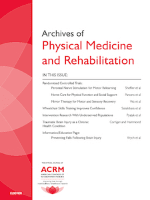
ARCHIVES OF PHYSICAL MEDICINE AND REHABILITATION
Empowering Rehabilitation: Bridging Research and PracticeArchives of Physical Medicine and Rehabilitation, published by W B Saunders Co-Elsevier Inc., is a premier academic journal dedicated to the fields of physical therapy, sports therapy, and rehabilitation. Since its inception in 1945, it has evolved to provide a platform for groundbreaking research and insightful discourse that shapes clinical practice and enhances patient outcomes. With a notable impact factor and ranking in the top quartiles of its respective categories, this journal consistently showcases the most innovative studies, systematic reviews, and evidence-based practices that drive forward the understanding of rehabilitation medicine. As a vital resource for researchers, healthcare professionals, and students alike, it contributes significantly to the advancement of knowledge in rehabilitation sciences. With an aim to bridge the gap between research and practice, the journal invites contributions from all disciplines related to physical medicine and rehabilitation, fostering a collaborative environment that promotes the dissemination of impactful findings.

European Journal of Physical and Rehabilitation Medicine
Breaking Barriers: Open Access to Revolutionary Rehabilitation KnowledgeWelcome to the European Journal of Physical and Rehabilitation Medicine, the premier peer-reviewed journal focusing on advancements in the fields of physical therapy, sports therapy, and rehabilitation. Published by EDIZIONI MINERVA MEDICA, this journal has established itself as a leading resource since its inception in 2008, now enjoying an impressive Q1 ranking in these disciplines according to 2023 metrics. With an emphasis on rigorous research and innovative clinical practice, the journal facilitates the dissemination of high-quality, evidence-based studies, contributing to the enhancement of patient care and therapeutic strategies. As an Open Access platform since 2022, the journal widens its reach, enabling researchers, clinicians, and students across the globe to access valuable insights without barriers. Residing in Italy, the journal's focus transcends regional confines, engaging a vibrant international community aimed at improving rehabilitation outcomes. Join us in exploring the latest developments that shape the future of rehabilitation sciences.
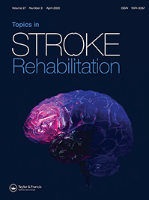
Topics in Stroke Rehabilitation
Leading the way in rehabilitation research.Topics in Stroke Rehabilitation, published by Taylor & Francis Ltd, stands as a premier academic journal offering cutting-edge research and insights in the fields of rehabilitation, neurology, and community care. With an impressive impact factor reflecting its strong scholarly influence, this journal not only maintains a distinguished Q1 ranking in Community and Home Care and Rehabilitation but is also recognized in the Q2 category for Clinical Neurology, showcasing its relevance across multiple disciplines. Covering a comprehensive range of topics from neurorehabilitation techniques to patient-centered care strategies, Topics in Stroke Rehabilitation serves as an essential resource for researchers, healthcare professionals, and students dedicated to enhancing the quality of life for individuals recovering from stroke. With an accessible archive dating back to 1996 and continuous publication through 2024, this journal invites collaboration and discourse, fostering advancements in both theoretical knowledge and practical applications within the realm of stroke rehabilitation.
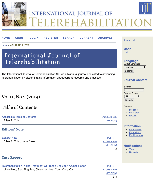
International Journal of Telerehabilitation
Exploring the future of health from a distance.The International Journal of Telerehabilitation, published by the University of Pittsburgh, University Library System, serves as a premier platform dedicated to advancing research in the emerging field of telerehabilitation. With an open access publishing model since 2009, this journal ensures that vital research findings are readily available to a diverse audience, which includes researchers, practitioners, and students. Covering key disciplines such as health informatics, rehabilitation, and computer science applications, the journal has earned notable rankings, positioning itself in the Q1 category within rehabilitation and Q2 in multiple related fields for 2023. Its impact is underscored by its rankings in Scopus, reflecting a strong commitment to enhancing accessibility and efficacy in health services. The journal endeavors to explore innovative approaches and technologies that enhance rehabilitation practices through telecommunication, paving the way for future developments in patient care and professional training. Researchers and professionals alike are encouraged to contribute to this vital discourse, making the journal an essential resource in the landscape of telehealth and rehabilitation.
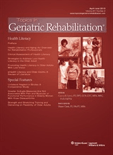
TOPICS IN GERIATRIC REHABILITATION
Innovating Rehabilitation for Aging PopulationsTopics in Geriatric Rehabilitation is a premier scholarly journal dedicated to advancing the field of geriatric rehabilitation, published by Lippincott Williams & Wilkins. With the ISSN 0882-7524 and an E-ISSN of 1550-2414, the journal has been a vital resource since its inception in 1985, providing a platform for innovative research and clinical studies that address the rehabilitation needs of older adults. It features a diverse range of articles that contribute significantly to the understanding of geriatric care practices, physical therapy, and rehabilitation strategies. Although currently categorized as Q4 in Geriatrics and Gerontology and Q3 in both Physical Therapy, Sports Therapy, and Rehabilitation, and general Rehabilitation, the journal continually strives to improve its scholarly impact and visibility within the medical community. The journal's eclectic content is invaluable for researchers, clinicians, and students alike, aiming to foster a better understanding of geriatric rehabilitation and improve health outcomes for older populations. With plans for expansion in open access options and a commitment to high-quality peer-reviewed content, Topics in Geriatric Rehabilitation remains dedicated to supporting advancements in this crucial field.
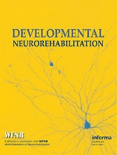
Developmental Neurorehabilitation
Advancing therapeutic innovation for developmental recovery.Developmental Neurorehabilitation is an esteemed journal published by Taylor & Francis Inc, dedicated to advancing the field of developmental neuroscience and rehabilitation. With an ISSN of 1751-8423 and an E-ISSN of 1751-8431, this journal serves as a vital resource for researchers, clinicians, and students interested in innovative therapeutic approaches and rehabilitation techniques for children and adolescents. Since its inception in 1997, Developmental Neurorehabilitation has focused on disseminating high-quality research, contributing to a deeper understanding of recovery processes in developmental disorders, and facilitating interdisciplinary dialogue among professionals. With its recognition in Q2 and Q3 quartiles across prominent categories such as Pediatrics and Rehabilitation, it stands out as a pivotal publication in its field, boasting Scopus rankings that reflect its significant impact—ranked #53 in Rehabilitation and #139 in Pediatrics, among others. While maintaining a commitment to quality research, the journal does not currently offer open access but remains accessible through institutional subscriptions, further enriching the academic landscape with critical insights into rehabilitation methodologies for developmental challenges and promoting better clinical practices to improve patient outcomes.

Turkish Journal of Physical Medicine and Rehabilitation
Empowering practitioners with cutting-edge insights.Turkish Journal of Physical Medicine and Rehabilitation, an esteemed publication by BAYCINAR MEDICAL PUBL–BAYCINAR TIBBI YAYINCILIK, serves as a premier platform for the dissemination of cutting-edge research in the fields of physical therapy, sports therapy, and rehabilitation. Established in 2018, this open-access journal has rapidly ascended within the academic community, boasting a commendable Q2 ranking in both Physical Therapy, Sports Therapy and Rehabilitation and Rehabilitation categories for 2023. With a significant Scopus rank reflecting its competitive standing, researchers and practitioners can access vital findings that advance clinical practices and enhance patient outcomes. Located in Istanbul, Turkey, the journal not only emphasizes accessibility but also encourages contributions that address the evolving challenges in the realm of physical medicine. As it continues to grow, the journal aims to foster a collaborative research environment, engaging both established and emerging scholars in the exploration of innovative rehabilitation strategies and methodologies.
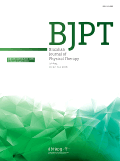
Brazilian Journal of Physical Therapy
Empowering Clinicians with Cutting-Edge InsightsBrazilian Journal of Physical Therapy (ISSN: 1413-3555; E-ISSN: 1809-9246), published by the ASSOCIACAO BRASILEIRA PESQUISA POS-GRADUACAO FISIOTERAPIA-ABRAPG-FT, stands at the forefront of contemporary research in physical therapy and rehabilitation. Hailing from Brasil, this esteemed journal has achieved remarkable recognition, proudly ranking in the Q1 quartile for Orthopedics and Sports Medicine, as well as Physical Therapy, Sports Therapy, and Rehabilitation, according to 2023 metrics. With a commendable Scopus ranking—positioned #10 out of 161 in Medicine Rehabilitation and #32 out of 247 in Health Professions Physical Therapy—this journal serves as a vital resource for researchers, clinicians, and students alike. It delivers cutting-edge research and innovative clinical practices, fostering advancements in treatment strategies and rehabilitation methodologies over its coverage span from 2007 to 2024. Although it operates under a traditional accessibility model, the journal's commitment to disseminating knowledge enhances the academic landscape of physical therapy and is indispensable for those dedicated to improving patient outcomes.